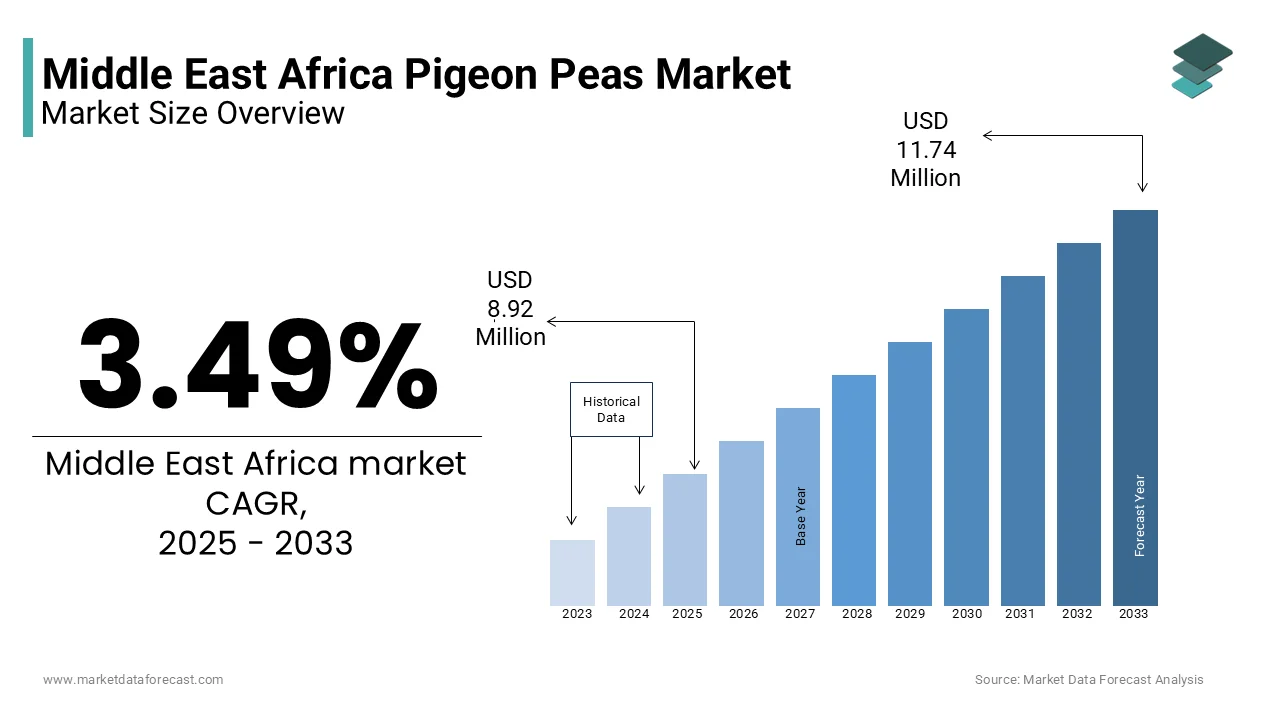Middle East and Africa Pigeon Peas Market Size, Share, Trends, & Growth Forecast Report – Segmented by Form (Frozen, Fresh, Canned and Dried), Price Range, Distribution Channel, and Country (KSA, UAE, Israel, South Africa, Ethiopia, Kenya, Egypt, Sudan, Rest of GCC Countries, and Rest of MEA) - Industry Analysis From 2025 to 2033
Middle East and Africa Pigeon Peas Market Size
The Middle East and Africa pigeon peas market size was valued at USD 8.62 million in 2024, and the market size is expected to reach USD 11.74 million by 2033 from USD 8.92 million in 2025. The market's promising CAGR for the predicted period is 3.49%.

The pigeon pea is a perennial legume that belongs to the family Fabaceae. Since its domestication in India at least around three and a half millennia ago, its seeds have become a common food grain in Africa, Asia and the Middle East and Africa. It is consumed on a large scale mainly in south Asia and is also a major source of protein for the population in the subcontinent. There are four varieties of pigeon peas which are tall varieties, dwarf varieties, tree types, and smaller bushes. Pigeon pea is one of the essential legume crops which originated in South Asia and is now growing in sub-tropical and tropical regions. Moreover, the largest pigeon peas producing regions are the Middle East and Africa, India, and Eastern Africa. Pigeon pea contains high levels of nutrition such as carbohydrates, vitamins, calories, proteins, and amino acids. Pigeon pea enhances soil fertilizer through symbiotic nitrogen fixation and enables farmers in having a valuable organic products and micronutrients. Pigeon pea is also used as a cover crop, green manure, intercrop and much more in various farming systems.
The driving factors of Middle East and Africa Pigeon Peas market are low cost of pigeon pea, long storage ease, advanced hybrid seed production technology, growing demand for processed products, rising production capacity, and logistical infrastructure. Moreover, consumers becoming health & nutrition conscious, increasing government investment in the agriculture sector and government initiatives for farmers' welfare are some of the other factors which can boost the demand for pigeon pea over the forecast period. However, seasonal changing patterns, unorganized sector, price fluctuation, high-quality standards, a threat from pathogens such as fusarium wilt disease and pests that attack crops and substitutes to pigeon pea are the foremost production are factors that are expected to constrain the growth of this market.
REPORT COVERAGE
|
REPORT METRIC |
DETAILS |
|
Market Size Available |
2024 to 2033 |
|
Base Year |
2024 |
|
Forecast Period |
2025 to 2033 |
|
CAGR |
3.49% |
|
Segments Covered |
By Form, Price Range, Distribution Channel, and Region |
|
Various Analyses Covered |
Global, Regional, & Country Level Analysis; Segment-Level Analysis; DROC; PESTLE Analysis; Porter’s Five Forces Analysis; Competitive Landscape; Analyst Overview of Investment Opportunities |
|
Regions Covered |
KSA, UAE, Israel, South Africa, Ethiopia, Kenya, Egypt, Sudan, Rest of GCC Countries, and Rest of MEA |
|
Market Leaders Profiled |
SYMAF Co Ltd., Sun Impex, Interamsa Agroindustrial SAC, Arvind Limited, A.B. Agro Company, Akyurek Kardesler Ltd., Taj Foods, Pulses Splitting & Processing Industry Pvt Ltd, Unitex Tanzania Limited, and others. |
MARKET SEGMENTATION
This research report on the Middle East and Africa pigeon peas market has been segmented and sub-segmented into the following categories.
By Form
- Frozen
- Fresh
- Canned
- Dried segments
By Price Range
- Mid
- Premium
- Low segments
By Distribution Channel
- Supermarkets
- Hypermarkets,
- Independent grocery stores,
- E-commerce
By Country
- UAE
- Israel
- KSA
- South Africa
- Egypt
The market in this region can be divided based on geography into Middle East and Africa regions. Factors such as growing preference of customers for fibre-rich foods and technological advancements are expected to drive the market growth in the region.
KEY MARKET PLAYERS
SYMAF Co Ltd., Sun Impex, Interamsa Agroindustrial SAC, Arvind Limited, A.B. Agro Company, Akyurek Kardesler Ltd., Taj Foods, Pulses Splitting & Processing Industry Pvt Ltd, and Unitex Tanzania Limited are playing dominating role in the Middle East and Africa pigeon peas market.
Frequently Asked Questions
1. What is the projected size of the Middle East and Africa pigeon peas market by 2033?
The market is expected to grow from USD 8.92 million in 2025 to USD 11.74 million by 2033, at a CAGR of 3.49%.
2. What factors are driving the growth of the pigeon peas market in this region?
Growth drivers include low cost, ease of storage, advanced hybrid seed production technologies, rising demand for processed products, and government support for agricultural development.
3. Which countries are major exporters of pigeon peas in Middle East and Africa region?
Tanzania and Kenya are leading exporters, with significant demand from India, Europe, and the Middle East due to their high protein content.
Related Reports
Access the study in MULTIPLE FORMATS
Purchase options starting from $ 1600
Didn’t find what you’re looking for?
TALK TO OUR ANALYST TEAM
Need something within your budget?
NO WORRIES! WE GOT YOU COVERED!
Call us on: +1 888 702 9696 (U.S Toll Free)
Write to us: [email protected]